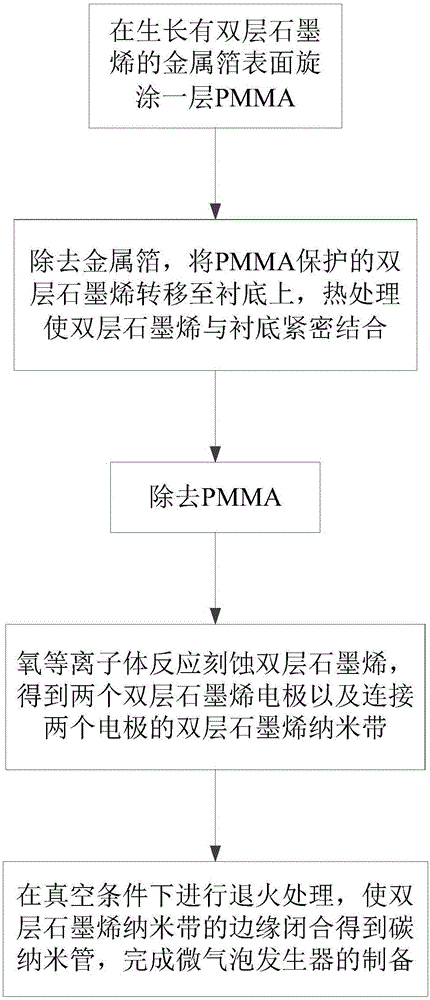A kind of preparation method of microbubble generator
A micro-bubble generator and double-layer graphene technology, applied in the field of micro-electromechanical systems, can solve the problems of easy corrosion and high power consumption, and achieve the effects of not easy electrolysis or corrosion, prolonging life, and flexible design
- Summary
- Abstract
- Description
- Claims
- Application Information
AI Technical Summary
Problems solved by technology
Method used
Image
Examples
preparation example Construction
[0018] Such as figure 1 with figure 2 As shown, the preparation method of the microbubble generator of the embodiment of the present invention comprises the following steps:
[0019] (1) spin-coat one deck PMMA4 on the surface of the metal foil 1 that grows double-layer graphene 11, as figure 2 (a) shown.
[0020] (2) corrode the metal foil 1 with ferric chloride or ammonium persulfate solution to obtain the double-layer graphene 11 protected by PMMA4, after cleaning with deionized water, transfer to the substrate 2 cleaned by the standard CMOS process, heat treatment Make bilayer graphene 11 and substrate 2 tightly combined, as figure 2 (b) shown.
[0021] (3) acetone soaking removes PMMA4, obtains the double-layer graphene 11 that is transferred on the substrate 2, as figure 2 (c) shown.
[0022] (4) Oxygen plasma reaction etching double-layer graphene 11, obtains two double-layer graphene electrodes and the double-layer graphene nanoribbon connecting two electrode...
Embodiment 1
[0029] The preparation method of microbubble generator comprises the steps:
[0030] (1) Spin-coat a layer of PMMA with a thickness of about 200 nm on the surface of copper foil grown with double-layer graphene.
[0031] (2) corrode the metal foil with the ammonium persulfate solution of 0.5mol / L to obtain the double-layer graphene protected by PMMA, after cleaning 3 times with deionized water, transfer to the substrate cleaned by the standard CMOS process, blow After drying, bake at 150°C for 10 minutes to make the double-layer graphene tightly bond with the substrate.
[0032] (3) Soak in acetone for 1 h to remove the PMMA to obtain bilayer graphene transferred to the substrate.
[0033] (4) Cover the double-layer graphene with silicon oxide nanowires as a mask, and react the oxygen plasma to etch the double-layer graphene to obtain two double-layer graphene electrodes and a double-layer graphene nanoribbon connecting the two electrodes, The distance between the two electr...
Embodiment 2
[0036] The preparation method of microbubble generator comprises the steps:
[0037] (1) Spin-coat a layer of PMMA with a thickness of about 200 nm on the surface of copper foil grown with double-layer graphene.
[0038] (2) corrode the metal foil with 0.5mol / L ammonium persulfate solution to obtain the double-layer graphene protected by PMMA, after cleaning 4 times with deionized water, transfer to the substrate cleaned by the standard CMOS process, blow After drying, bake at 150°C for 10 minutes to make the double-layer graphene tightly bond with the substrate.
[0039] (3) Soak in acetone for 1 h to remove the PMMA to obtain bilayer graphene transferred to the substrate.
[0040] (4) Cover the double-layer graphene with silicon oxide nanowires as a mask, and react the oxygen plasma to etch the double-layer graphene to obtain two double-layer graphene electrodes and a double-layer graphene nanoribbon connecting the two electrodes, The distance between the two electrodes is...
PUM
| Property | Measurement | Unit |
|---|---|---|
| width | aaaaa | aaaaa |
Abstract
Description
Claims
Application Information
 Login to View More
Login to View More - R&D
- Intellectual Property
- Life Sciences
- Materials
- Tech Scout
- Unparalleled Data Quality
- Higher Quality Content
- 60% Fewer Hallucinations
Browse by: Latest US Patents, China's latest patents, Technical Efficacy Thesaurus, Application Domain, Technology Topic, Popular Technical Reports.
© 2025 PatSnap. All rights reserved.Legal|Privacy policy|Modern Slavery Act Transparency Statement|Sitemap|About US| Contact US: help@patsnap.com


